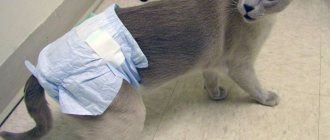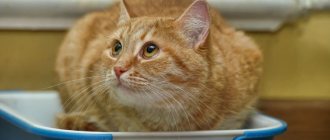Should cat owners be concerned if they find blood or mucus in their cat's stool? In this article, we describe in sufficient detail the probable causes of these phenomena and answer the main question: “is it dangerous?”
We all do it. We do this every time we change the tray or hear claws scraping the litter. I'm talking about examining our cat's poop. We humans have an inexplicable interest in monitoring the waste products of our companion. And this is good. Identifying a litter box problem early can prevent more serious complications and restore the health of a sick kitten. According to statistics, intestinal upset/diarrhea is the sixth most common disease in cats. One of the most common intestinal problems reported by cat owners is blood or mucus in the stool. Should you be concerned if you notice drops of blood or clots of mucus in your cat's litter box? Let's find out.
What does normal cat stool look like?
Typical cat poop is about 5-6 cm long, 1 cm in diameter, well formed and predominantly brown in color. If your cat has abnormal bowel movements, you can give your assessment of the feces. Assessing the quality of feces and estimating the quantity can help your veterinarian diagnose your cat's condition more quickly and correctly.
Most cats defecate once a day. The smell should not be too strong. When changing the tray, you may notice that normally the stool should not be liquid.
Diagnosis and treatment
Blood in the stool can indicate a wide range of diseases. That’s why you shouldn’t self-medicate or ignore the problem altogether. Only a doctor can make an accurate diagnosis after conducting a series of studies.
First, the veterinarian will interview the owner. It is necessary to talk about whether the cat has any other symptoms of the disease, describe the pet’s diet, does the cat have access to household chemicals or other items that it could swallow, has it previously had diarrhea or constipation, has it cleaned The cat's stomach has been affected by fur lately.
First of all, the doctor will take stool for analysis. Using a microscope, he will be able to eliminate the possibility of parasitic infestation. A general blood test can indicate the presence of any inflammatory processes in the animal’s body, or anemia. In addition, blood should be examined for clotting.
A general urine test will help determine whether there are inflammatory processes in the kidneys. With the help of palpation, you can determine the presence of anal fissures and tumors, and assess the condition of the paraanal glands.
An ultrasound of the abdominal area will help to see the inflammatory processes occurring in the internal organs. X-rays (including the use of contrast) will help detect foreign objects in the intestines.
In some cases, endoscopy is necessary to make an accurate diagnosis. The same method can eliminate minor bleeding in the intestines and take tissue for analysis. The procedure is performed under anesthesia.
Treatment directly depends on the diagnosis.
- If the cause is parasitic infestation, the cat is given anthelmintics. Moreover, the medicine must be given several times with an interval of 10 days until all the helminths leave the body along with the feces.
- For infectious diseases, a course of antibiotics is prescribed. You may also have to give your animal anti-inflammatory and painkillers.
- When there is an intestinal blockage, the animal is first given castor oil or given an enema. If the stuck object is too large, surgical intervention is prescribed. Surgery is also prescribed in case of tumors appearing on the intestinal walls. Surgery is especially important if the tumors are growing.
- When the anal glands become inflamed, the doctor cleans the clogged pores and removes all the accumulated pus.
- If anal fissures occur, special suppositories with sea buckthorn oil are prescribed. The owner can administer the suppositories himself 2 times a day. In this case, the animal must be held in your arms for about ten minutes until the candle melts.
- In case of poisoning, the cat's stomach is cleansed and medications are given that remove toxins from the animal's body. If there is excessive vomiting and dehydration, the animal is given a drip.
- If you experience frequent constipation, your doctor will prescribe a special diet. You can add food to your diet that is intended for animals with gastrointestinal disorders. In some cases, dry food is completely removed from the diet, replacing it with canned food or natural food.
We recommend the article: How to rid a cat of growths on his pads?
What does blood look like in my cat's stool?
Blood in a cat's stool can be difficult to detect. For starters, cat litter can sometimes change color and hide or create changes in the appearance of the stool. If the blood originates in the lower intestine, especially the distal colon or rectal area, it will most likely appear as blood. Red or pink drops or smears are often found on the sides of the cat's litter box and on the top of the stool or litter.
Blood from the upper intestinal tract, especially the small intestine, will be black or brown. This color change is due to partial digestion by enzymes secreted in the small intestine. This blood often appears as dark spots, streaks, or looks like coffee grounds.
It's important to note that both constipation and diarrhea can cause blood in a cat's stool. Bright red blood without diarrhea or hard, dry stool usually indicates the problem is closer to the rectum and anus.
Causes of blood in stool
The animal owner’s task is to notice characteristic changes in the state of his pet’s body. The appearance of blood or mucus in a cat’s feces is a reason to contact a veterinary hospital for an accurate diagnosis, since independent determination of the provoking factors is impossible.
There are many reasons for the development of a pathological symptom, but the most common are:
- Infection with helminth infections - parasitic organisms, penetrating into the animal’s body, begin to damage the mucous membrane of the intestinal tract. As a result of the influence of helminths on the intestinal walls, drops of blood appear in the cat’s stool, and other characteristic symptoms also occur - diarrhea, mucus in the feces, pain in the abdominal area.
- Foreign objects in the intestines . If parts of the intestine are damaged or partially blocked by plastic objects or sharp parts of tubular bones, there is a high probability of intestinal trauma. When damaged, symptoms such as refusal to eat, feces mixed with blood, depression, and increased apathy occur.
- Chronic constipation . Heavily compressed and hard feces when passing through the anus can injure the mucous membrane, causing a pathological condition.
- Intoxication of the body with strong poisons. Poisoning an animal with zoocoumarins (poisons intended for baiting rodents) leads to disruption of clotting factors, causing bleeding throughout the body. In addition to blood and mucus in the feces, when poisoned by poisons, an animal may experience bleeding from various places - the nose, mouth, eyes.
- Neoplasms . Tumors of a malignant or benign nature formed in the intestines can provoke extravasation, manifested by blood impurities in the feces.
- Inflammation of the glands in the anal area . Derivatives of the sweat and sebaceous glands located at the transition of the rectum to the anus, secreting a specific secretion - liquid for marking territorial boundaries. Inflammation in the anal glands makes it difficult for the feces to pass out, causing pain and discomfort to the animal. When the integrity of the mucous membrane is violated, blood appears in the stool during the act of defecation.
- Parvovirus and coronavirus enteritis. Infectious diseases affecting the intestinal tract most often affect young cats and kittens. The danger of enterovirus infections lies in the rapid development of pathology, accompanied by diarrhea in the cat, extravasation in the feces due to a violation of the integrity of the intestinal mucosa and some other characteristic signs.
- Problems with clotting factors. A disease such as hemophilia also occurs in representatives of the cat family. The disease manifests itself not only by the appearance of blood in the stool, but also by other characteristic symptoms - extravasation from the nasal and oral cavities, prolonged wound healing, and weak immunity.
- Diseases of internal organs . The reasons for the appearance of bloody stools or feces with streaks of heme may be associated with disruption of the functioning of internal organs - the liver, pancreas, small or large intestine, as well as with stomach ulcers.
- Bacterial infections. The penetration and development of pathogenic microflora in the intestines of an animal can provoke serious disruptions in the functioning of the organ. Bacteria such as salmonella, campylobacteria, E. coli or colibacteria lead to dehydration and diarrhea with blood. Not timely treatment of a bacterial infection leads to the death of the animal.
- Cracks or wounds in the anal area . Damage to the anal sphincter not only leads to problems with defecation and the appearance of blood particles in the feces, but also causes discomfort to the pet. The cat may simply be afraid to go to the toilet for a long time due to painful sensations.
Particularly worth noting is diarrhea with blood in a pregnant cat, because this condition threatens the life of the pet. The cause of streaks of blood in loose, watery stools are inflammatory processes in parts of the large intestine, tumor processes, or infectious diseases.
If a severe symptom occurs that lasts more than two days, you should take your pet to a veterinarian for further thorough examination.
What about mucus in the stool?
Slippery. Slimy. Nasty. These are all words veterinarians hear from cat owners describing excessive mucus in their cats' stool. Mucus is a normal secretion of the intestinal tract to help lubricate and moisten the intestines and facilitate fecal passage. It is not uncommon to observe some greasy or slippery coatings on your cat's feces. It is abnormal to see a lot of mucous, often clear to pale yellow-green fluid, accompanying your cat's bowel movements. Fecal mucus is an example of “the more the merrier.”
Scarlet and pink discharge
By emptying the stomach, the animal is freed from fluff, an accidentally swallowed thread, or a bead, but not every owner knows what to do when a cat vomits blood. Fresh scarlet inclusions are released when the oral mucosa is injured by bone, pieces of unchewed food, or when a tooth falls out. With prolonged fasting, reddish traces are noticeable in the bile expelled by the stomach; the cat vomits with blood of a scarlet hue:
- with a tumor in the esophagus;
- in case of organ damage;
- when the shell is corroded, which occurs after the use of drugs.
In case of intoxication, which occurs from poisoning with spoiled food, the cat vomits for a long time, and this leads to the rupture of capillaries, which color the saliva and vomit scarlet.
The pink foam that comes out of your pet’s mouth is formed when there is a strong cough that occurs during a cold or when the respiratory tract is infected.
What causes blood or mucus in my cat's stool?
There can be many reasons for blood or mucus in your cat's stool. Some common reasons include:
- Dietary changes and food intolerances;
- Inflammatory bowel diseases (IBD);
- Intestinal parasites such as Giardia;
- Infections;
- Trauma or abscess;
- Rectal polyps or tumors;
- anal gland abscess or infection;
- Constipation or idiopathic feline megacolon;
- Poisons or toxins;
- Cancer.
What can an owner do before going to a veterinary hospital?
If the owner begins to notice that the cat has blood in its stool, he needs to observe the pet before taking it to the veterinarian. You should pay particular attention to the following points :
- how often does blood appear in the cat’s stool (every time he visits the litter box or just once);
- how the cat behaves in the tray (worry, tense or, conversely, calm and relaxed);
- how much blood does the stool contain (a few drops, clots, or a large amount);
- are there foreign impurities in the stool (undigested food, mucus, hairballs);
- whether the cat’s appetite has changed, whether the animal is suffering from thirst;
- does the cat have a fever?
- Your pet may be suffering from vomiting or diarrhea.
If you find blood in your cat's feces, observe the general condition of the animal. The slightest changes in behavior, the presence of thirst, loss of appetite, lethargy, or the entry of a foreign body into the cat’s body should be discussed with the veterinarian at the appointment. A specialist, having determined the causes of blood inclusions in a cat’s stool, will be able to quickly make a diagnosis and develop an effective treatment plan. Thanks to this, the life and health of your pet will be preserved.
What will the veterinarian do to determine the cause?
Most of these problems can be diagnosed based on the animal's medical history, physical examination, and microscopic examination of the animal's stool. Your veterinarian will look for blood, parasites, bacteria, and other possible causes of blood and/or mucus. In more serious cases, X-rays, ultrasound, blood and urine tests will be performed. Treatment will be based on an accurate diagnosis.
If you notice anything strange in your cat's feces, don't hesitate; Contact us for veterinary help. We've seen too many cats for whom it was too late to get help, simply because their owners hoped to solve the poop problem on their own. And our best advice is to continue to monitor your cat litter carefully.
If you are unsure, consult with our veterinarian—they will be your best resource in determining which toys and objects are safe for your cat, and can also give you tips on how to prevent your cat from eating strange objects.
Diagnostic testing for vomiting in a cat
Due to the severity of the symptom and the long list of possible causes, your cat may be offered standard tests and additional investigations.
Call a veterinarian Moscow
+7(495)162-70-70
- Complete blood count, urinalysis and biochemical profile.
To assess your cat's overall health, look for signs of infection, inflammation, liver function, and platelet count.
- Endoscopy.
To identify tumors, ulcers and foreign objects in the digestive tract.
- Biopsy of the intestinal tract.
To identify inflammatory cells in the intestinal wall.
- A test to measure blood clotting time.
- Stool examination.
Under a microscope to check for the presence of worm eggs.
- Ultrasound or X-ray.
To assess the presence of foreign objects, neoplasms and examine internal organs.
Diagnostic features
To find out why a cat has blood in its stool, a veterinarian performs a diagnosis. The procedure involves the use of different techniques, but first of all, blood is taken for a detailed analysis. It is also necessary to submit your pet’s stool to be examined for protozoan microorganisms and helminths, as well as to detect internal bleeding.
A laboratory method called coprogram is highly informative at the stage of diagnosing diseases in cats. With its help, you can find out what microscopic composition the blood in cat feces has, as well as identify hidden bleeding. Additional tests performed when blood is detected in a cat's stool :
- Analysis of urine;
- Ultrasound of the abdominal organs;
- X-ray of the abdominal organs;
- colonoscopy examination.
© shutterstock
A set of diagnostic procedures allows the veterinarian to make the correct diagnosis and create an effective treatment regimen.









